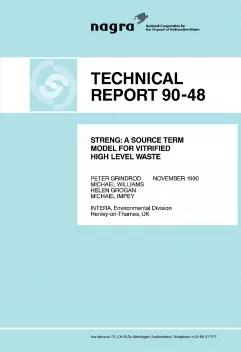
Technical Report NTB 90-48
STRENG: A source-term model for vitrified high-level waste
A source term model STRENG has been devised to analyse the diffusive release of radionuclides from vitrified high level waste in a repository with cylindrical geometry. The model includes the dissolution of the glass waste matrix, the diffusive transport of the radionuclides through a bentonite clay buffer, the effects of solubility limits, as well as the radioactive decay and ingrowth.
The model requires as input the following parameters:
- Radioactive decay constants and decay chain structure
- Initial inventories of the radionuclides in the repository
- Canister failure time
- The elemental solubility limits for the waste
- Details of the physical properties of the repository
- Details of the physical and chemical properties of the glass matrix
- The retardation factors of the elements in the bentonite buffer
- A list of times at which the output is required
From the above data the model produces as output:
- The flux of radionuclides into the host rock
- The inventory of the radionuclides remaining in the glass matrix
- The rate at which radionuclides are released from the glass matrix
- The inventory of precipitated species in the pore-water when the glass dissolves
STRENG utilises user-friendly menu screens for the pre- and post-processing of the data used. Within this framework it provides a quick view graphical output of the flux to the geosphere together with the facility to store these results in a form more suited to a professional graphics package. In order to form part of a larger modelling effort, STRENG produces output in a form desired by Nagra for their subsequent groundwater flow/transport codes for modelling the geosphere transport.
